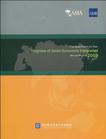博鳌亚洲论坛亚洲经济一体化进程2009年度报告
2010-3
对外经济贸易大学出版社
本社 编
90
166000
This report represents a report card on the progress of economic integration in Asia under the currentglobal financial crisis. It describes some of the major economic issues in the Asia-Australia region in the past,especially those events in the year 2009.The report describes in detail the impacts of the global financial crisis on Asia, how the Asian economiesperformed during the crisis, how they responded to the hardship caused by the global financial crisis andthe encouraging signs that Asia is leading the world on the recovery path. Notably, China and India, the twomost populous and fast-growing economies were able to maintain positive growth throughout the crisis.Their outstanding performance in growth and recovery have contributed substantially to the global efforts toovercome the current difficulties.With the severity of the global financial crisis Asia stood firm to intensify its efforts for closer economiccooperation among its members. The Asian economies are more inter-dependent on each other than everbefore, with freer movements of goods, services, and capital. Faced with rising global protectionism, Asiacalled for greater trade and today's Asia has emerged as a great guardian of the free global trading system.The report also examines the progress of economic integration and cooperation in Asia, including theASEAN Plus Three process, the APEC and the possibility of fulfilling its goal of becoming a free trade area,the progress of economic integration in sub-regions of Asia. As a matter of fact, the process of economicintegration in Asia is very much alive and is moving forward at a steady speed.The Copenhagen Meeting, the environmental issues and the work done by the Asian governments arenot ignored in this report.The significance of these issues is that in terms of climate change and environmentalprotection, there has not been any formal cooperation framework among Asian members. Thus, the issuesprovide new opportunities for intensified regional cooperation.Asia is leading the world on the recovery path after the global financial crisis, and there is strongevidence that Asia will continue to maintain its vitality and dynamism. No doubt, economic integration inAsia is intensifying, with more intensive and extensive cooperation and mutual dependence among theeconomies, through the channels of trade, investment, finance, and macroeconomic coordination. We trustthat the Asian members will make continued and joint efforts to overcome the current financial crisis andfulfill the goal of an integrated Asia.
本报告为博鳌亚洲论坛与亚洲开发银行合作的权威性经济分析报告。 《报告》表示,各国ZF积极推动区域内贸易自由化,使亚洲经济体对区域内经济的依赖度不断上升,对区域外经济的依赖度逐渐下降。《报告》称,区域贸易协定(RTAS)数量急剧增加是亚太地区的显著特点。据有关资料显示,截止2009年,亚洲共有自由贸易协定221个,其中112个是已达成协定的,49个是提议中的,16个为框架性的,44个正处在谈判中。 《报告》详细分析了东盟“十加三”、APEC,以及东亚、中南半岛地区、东南亚和南亚等四个次区域的一体化进程。东盟正努力加强与区域内伙伴的经济关系。
ACRONYMSACKNOWLEDGEMENTSFOREWORDLIST OF CONTRIBUTORSChapter 1 The Asian Economies under the Global Financial Crisis: Recovery and Growth 1.1 Recovery and Growth of the Asian Economies 1.2 Responses of the Central Banks of the Asian Economies 1.3 Protectionism and Its ContainmentChapter 2 Trade and Investment Flows 2.1 Foreign Trade of Asian Economies 2.2 Foreign Direct investmentChapter 3 Regional Cooperation and Economic Integration of the Asian Economies 3.1 Dramatic Rise of Regional Trade Agreements 3.2 ASEAN+3 and Beyond 3.3 APEC: A Possible Free Trade Area 3.4 Regional Economic Cooperation 3.5 The Degree of Correlation among the Asian EconomiesChapter 4 The Copenhagen Meeting and the Environment: A New Challenge for Cooperation in Asia 4.1 Joint Efforts of China and India at the Meeting 4.2 Environmental Situation in Asia 4.3 Efforts of Various Asian GovernmentsAppendix Ⅰ Chronological Dates of Economic Integration Agreements in AsiaAppendix Ⅱ Number of FTAs in Asia by Status (1975-January 2010)REFERENCES
插图:The 2008 global financial crisis severely hit manyeconomies in Asia, but the year of 2009 broughthope to these economies. For most parts of Asia,the worst seemed to be over, and there were signsof recovery everywhere. Asia is still not back to thepre-crisis level yet, but the recent developments areencouraging.The Asian economies experienced differentperformance levels during the crisis and adopteddifferent policy packages to stimulate theireconomies. As a result, the economies followeddifferent paths of recovery and performed quitedifferently.China stood out to be the best performingeconomy after the outbreak of the global financialcrisis. It had maintained positive growth in al'lquarters since late 2008, even though many othereconomies in Asia - large or small - experiencednegative growth. China's economy grew with astrong rate of 9.0 percent in terms of its real GDP inthe third quarter of 2008 on a year-on-year basis,just before the financial crisis, but the growthslowed down to 6.8 percent in the next quarterright after the outbreak of the financial crisis. Afterreaching a trough of 6.2 percent in the first quarterof 2009, China's GDP growth accelerated to 7.9percent, 9.1 percent and 10.7 percent in subsequentquarters, resulting in an enviable annual growth of8.7 percent in 2009.
《博鳌亚洲论坛亚洲经济一体化进程2009年度报告(英文版)》由对外经济贸易大学出版社出版。

博鳌亚洲论坛亚洲经济一体化进程2009年度报告 PDF格式下载